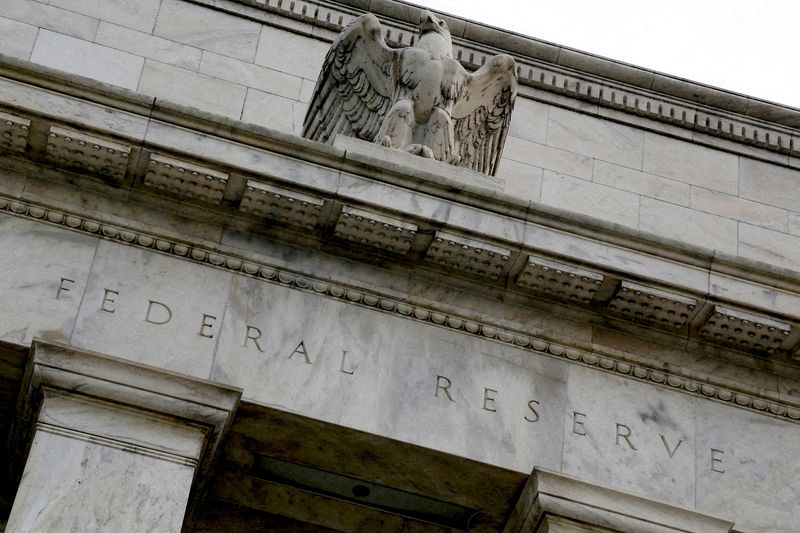By Lewis Krauskopf
NEW YORK (Reuters) - The prospect of near-term interest rate cuts is bolstering the case for investors to remain bullish after a run in U.S. stocks that may soon be tested by upcoming corporate earnings reports and growing political uncertainty.
Expectations that the Federal Reserve will kick off its long-awaited rate-cutting cycle in September remained firm on Tuesday after Fed Chair Jerome Powell told Congress that the U.S. is “no longer an overheated economy,” suggesting that the case for easing monetary policy is growing stronger.
Rate-cut bets have fluctuated sharply throughout the year and have been only one of several factors - along with strong earnings and excitement over artificial intelligence - that have helped the S&P 500 rise about 17% year-to-date. Still, many investors believe increased clarity on when the Fed will begin easing monetary policy and how much it might lower rates in 2024 could provide a buffer to stocks if markets grow turbulent in coming months.
The beginning of rate cuts will signal that "the Fed has the market's back," said Yung-Yu Ma, chief investment officer at BMO Wealth Management. He expects the central bank to cut rates about six times over the next year. “We think that's definitely a positive factor both for the markets and the economy,” he said.
Investors late on Tuesday were factoring in an over 70% chance that the Fed will cut rates in September, compared with roughly 50% a month ago, according to CME FedWatch. Fund funds futures are pricing in about 50 basis points of easing in 2024 overall, according to LSEG data.
“The Fed is getting closer to a rate cut,” said Peter Cardillo, chief market economist at Spartan Capital Securities. “I believe we’ll see a rate cut in September and another one in December.”
CHALLENGES AHEAD
Powell told the Senate Banking Committee that inflation had been improving in recent months and that "more good data would strengthen" the case for looser monetary policy.
One early test comes on Thursday, with the release of U.S. consumer price data for June. While the last several reports have shown that inflation is starting to cool, a stronger-than-expected number could undermine the case for easing in coming months.
On the other hand, expectations of coming monetary easing combined with easing inflation and still-resilient growth could buoy investor confidence in the face of several potential risks in coming weeks.
Corporate earnings kick off in earnest on Friday with reports from major banks and could weigh on the richly valued U.S. equity market if companies fail to deliver on lofty expectations. S&P 500 companies are expected to increase earnings 10.6% this year and 14.5% in 2025, according to LSEG IBES.
Investors are also bracing for the twists and turns in the U.S. presidential election race, after President Joe Biden’s shaky debate performance late last month against former President Donald Trump prompted calls for the incumbent to step aside.
Keith Lerner, co-chief investment officer at Truist Advisory Services, wrote in a recent midyear outlook that he remains positive on U.S. stocks, although he expects markets to trade “in a choppier fashion” following a strong first half.
"U.S. economic growth is now cooling from the post-pandemic stimulus boom, but not weak,” he said. Stocks have typically risen in the six- to 12-month period following the Fed’s first rate cut, as long as the economy avoids recession, Truist’s research showed.
Lower interest rates could also help broaden the equity rally, which has been led by a handful of megacap companies like Nvidia (NASDAQ:NVDA). Only 24% of stocks in the S&P 500 outperformed the index in the first half, the third-narrowest six-month period since 1986, according to BofA Global Research strategists.
Matt Miskin, co-chief investment strategist at John Hancock Investment Management, said lower rates could help areas of the markets that have suffered under higher rates as big tech has soared. That includes small-cap companies, which tend to be more sensitive to interest rates because of their greater reliance on financing. The small cap-focused Russell 2000 is up just 0.1% year-to-date.
"Smaller-cap companies need capital to survive in a lot of instances and this higher cost of capital makes their business really challenged,” he said. “A lower cost of capital would certainly help those companies."
Of course, rate cuts are not always a signal of smooth sailing ahead and have often come when the Fed is forced to rapidly ease monetary policy due to a deteriorating economy.
A study by the Wells Fargo Investment Institute released last month found that the S&P 500 has fallen by an average of 20% in the 250 days following the first cut of a cycle.

Stocks will likely perform well over the next six to 18 months if the Fed cuts rates due to falling inflation, the firm’s strategists wrote.
However, “if the Fed is forced to cut aggressively in response to a macro or market disruption, we would expect stock performance to suffer,” they wrote.